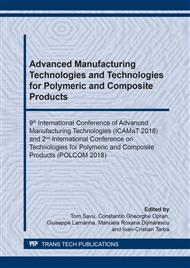p.348
p.358
p.369
p.379
p.389
p.399
p.409
p.417
p.427
Study about Mechanical Properties of Materials Obtained by Thermoforming
Abstract:
Plastic materials have played a very important role in the development of our modern civilization. It can be said that plastic materials are a tribute to man’s creativity and inventiveness. Plastic materials are the key to the innovation of many products and technologies in various sectors such as electrical and electronic equipment, packaging, civil engineering, agriculture, power generation, medical and pharmaceutical industry, aerospace and not last automotive industry. An increasingly important aspect in the automotive industry, in terms of fuel consumption is the lower weight of the components, while maintaining a very high stiffness. The difficulties of the design process of thermoformed parts is mainly due to the lack of knowledge by designers about the constraints and forces that are required during the process of thermoforming.
Info:
Periodical:
Pages:
389-398
Citation:
Online since:
June 2019
Authors:
Keywords:
Price:
Сopyright:
© 2019 Trans Tech Publications Ltd. All Rights Reserved
Share:
Citation:


